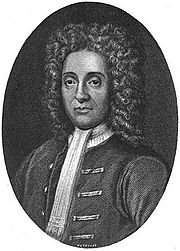
Abraham Sharp
Encyclopedia

Biography
Sharp was born in Horton Hall in Little HortonLittle Horton
Little Horton is a Ward in Bradford Metropolitan District in the county of West Yorkshire, England, named after the de -Horton family,who were once Lords of the Manor....
, Bradford
Bradford
Bradford lies at the heart of the City of Bradford, a metropolitan borough of West Yorkshire, in Northern England. It is situated in the foothills of the Pennines, west of Leeds, and northwest of Wakefield. Bradford became a municipal borough in 1847, and received its charter as a city in 1897...
, the son of well-to-do merchant John Sharp and Mary (née Clarkson) Sharp and was educated at Bradford Grammar School
Bradford Grammar School
Bradford Grammar School is a co-educational, independent school in Frizinghall, Bradford, West Yorkshire. Headmaster, Stephen Davidson is a member of the Headmasters' and Headmistresses' Conference . The school was founded in 1548 and granted its Charter by King Charles II in 1662...
.
In 1669 he became a merchant's apprentice before becoming a schoolmaster in Liverpool
Liverpool
Liverpool is a city and metropolitan borough of Merseyside, England, along the eastern side of the Mersey Estuary. It was founded as a borough in 1207 and was granted city status in 1880...
and subsequently a bookkeeper in London
London
London is the capital city of :England and the :United Kingdom, the largest metropolitan area in the United Kingdom, and the largest urban zone in the European Union by most measures. Located on the River Thames, London has been a major settlement for two millennia, its history going back to its...
. His wide knowledge of mathematics
Mathematics
Mathematics is the study of quantity, space, structure, and change. Mathematicians seek out patterns and formulate new conjectures. Mathematicians resolve the truth or falsity of conjectures by mathematical proofs, which are arguments sufficient to convince other mathematicians of their validity...
and astronomy
Astronomy
Astronomy is a natural science that deals with the study of celestial objects and phenomena that originate outside the atmosphere of Earth...
attracted Flamsteed's
John Flamsteed
Sir John Flamsteed FRS was an English astronomer and the first Astronomer Royal. He catalogued over 3000 stars.- Life :Flamsteed was born in Denby, Derbyshire, England, the only son of Stephen Flamsteed...
attention and it was through Flamsteed that Sharp was invited, in 1688, to enter the Greenwich Royal Observatory. There he did notable work, improving instruments and showing great skill as a calculator, publishing Geometry Improved and logarithmic tables.
Sharp calculated pi
Pi
' is a mathematical constant that is the ratio of any circle's circumference to its diameter. is approximately equal to 3.14. Many formulae in mathematics, science, and engineering involve , which makes it one of the most important mathematical constants...
to 72 decimal places using an arcsine sequence, briefly holding the record until John Machin
John Machin
John Machin, , a professor of astronomy at Gresham College, London, is best known for developing a quickly converging series for Pi in 1706 and using it to compute Pi to 100 decimal places.Machin's formula is:...
calculated 100 digits in 1706.
He returned to Little Horton in 1694. When the Atlas Coelestis
Atlas Coelestis
The Atlas Coelestis is a star atlas published posthumously in 1729, based on observations made by the First Astronomer Royal, John Flamsteed.The Atlas - the largest that ever had been published - contains 26 maps of the major constellations visible from Greenwich, with drawings made in the Rococo...
- the largest star map at the time was published - it contained 26 maps of the major constellation
Constellation
In modern astronomy, a constellation is an internationally defined area of the celestial sphere. These areas are grouped around asterisms, patterns formed by prominent stars within apparent proximity to one another on Earth's night sky....
s visible from Greenwich
Greenwich
Greenwich is a district of south London, England, located in the London Borough of Greenwich.Greenwich is best known for its maritime history and for giving its name to the Greenwich Meridian and Greenwich Mean Time...
and two planisphere
Planisphere
A planisphere is a star chart analog computing instrument in the form of two adjustable disks that rotate on a common pivot. It can be adjusted to display the visible stars for any time and date. It is an instrument to assist in learning how to recognize stars and constellations...
s designed by Sharp.
Sharp died in Little Horton in 1742. He never married. He was a great-uncle of Jesse Ramsden
Jesse Ramsden
Jesse Ramsden FRSE was an English astronomical and scientific instrument maker.Ramsden was born at Salterhebble, Halifax, West Riding of Yorkshire, England. After serving his apprenticeship with a cloth-worker in Halifax, he went in 1755 to London, where in 1758 he was apprenticed to a...
, the scientific instrument maker.
An English translation of a memorial tablet in Latin in Bradford cathedral reads " He was rightly counted among the most accomplished mathematicians of his day. He enjoyed constant friendship with the very famous men of the same repute, notably Flamsteed and the illustrious Newton. He drew up the description of the heavens made by the former of these (Flamsteed) in (astronomical) tables of the greatest accuracy; he also published anonymously various writings and descriptions of instruments perfected by himself... .
The crater Sharp
Sharp (crater)
Sharp is a lunar impact crater located to the west of the Sinus Iridum bay of the Mare Imbrium, beyond the Montes Jura range. To the southwest is the crater Mairan. Because of its location and foreshortening, Sharp appears elliptical whereas the crater rim is actually circular.Sharp is surrounded...
on the Moon
Moon
The Moon is Earth's only known natural satellite,There are a number of near-Earth asteroids including 3753 Cruithne that are co-orbital with Earth: their orbits bring them close to Earth for periods of time but then alter in the long term . These are quasi-satellites and not true moons. For more...
is named after him.

